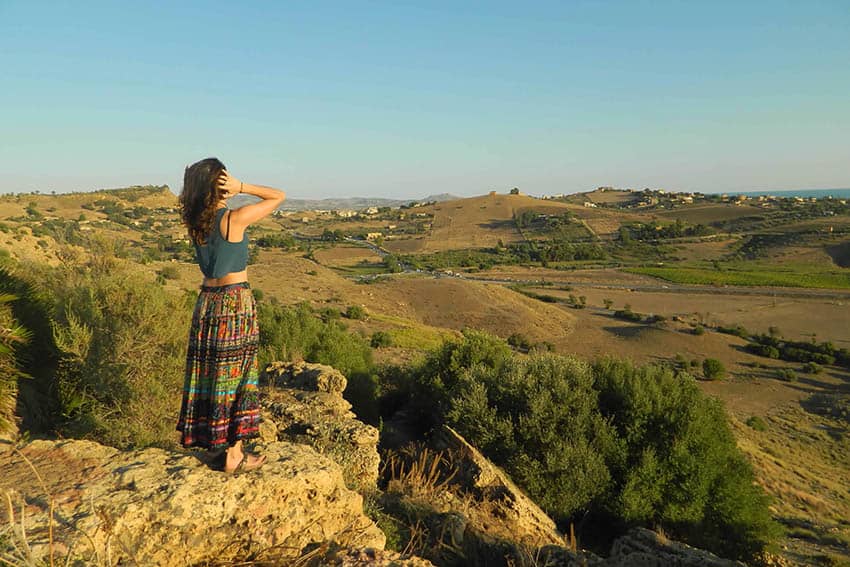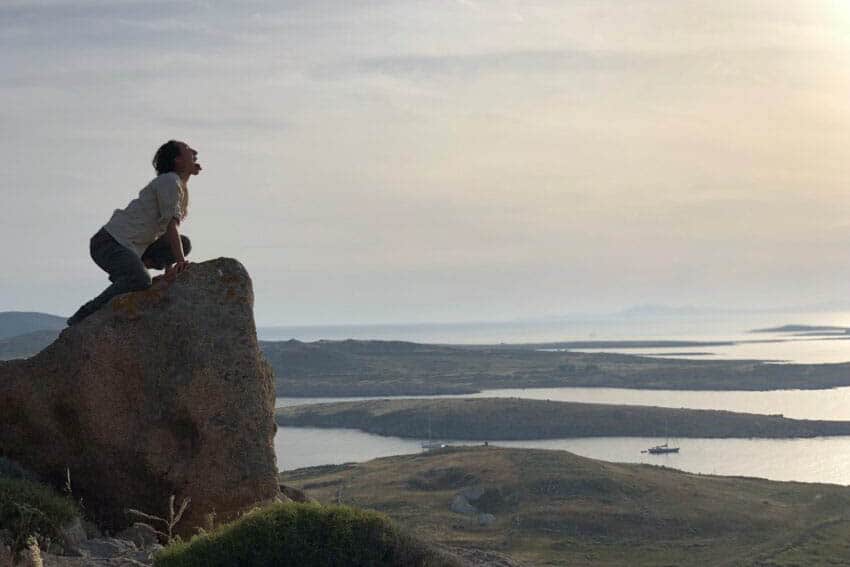
Staying Safe, But Not Giving Up Your Travel Dreams as a Solo Woman Traveler
Vagabondess: A Guide to Solo Female Travel is a book for women—and all people!—who want to travel solo, face their fears, and live the adventure of their dreams.

This book is for the travelers (current and future), the feminists, the adventurers, the seekers, and the curious. It is the guide I never had, and the advice I might not have heeded anyway. In these pages, I offer the insights I gleaned from moving through the world as a vagabondess for the better part of the last ten years.
Vagabondess is much more than a guide. It is a collection of travelogue, philosophy, stories, and, yes, travel advice. It is about embracing the vagabondess—her spirit of adventure, her curiosity, her dedication to growth and discovery—who lives inside each of us, showing up in our lives in a myriad of ways.
If you were waiting for someone to tell you that your dreams are just crazy enough, and then give you some practical suggestions for how to get there, then this is the book for you.
Excerpt from chapter 8 Staying Safe: Boundaries, Self-Defense, & The Dark Goddess
By Toby Israel
 This chapter could go a lot of different ways. Conventional wisdom tells you not to wear revealing clothing, to watch your drinks, and to never, ever go into a stranger’s home.
This chapter could go a lot of different ways. Conventional wisdom tells you not to wear revealing clothing, to watch your drinks, and to never, ever go into a stranger’s home.
Conventional wisdom also tells you to simply not travel alone while ignoring the fact that women are at greater risk at home than anywhere else, so let’s just leave that all to the side and take this in another direction.
(Of course, it is a good idea to watch your drinks, and I generally am in favor of dressing appropriately according to the values of your host culture.)
If you want someone to tell you that traveling solo is too dangerous, you have your mom, partner, or best friend. I would rather discuss practical tools for staying safe anywhere, for those of you who have already decided not to listen and to go and see. Keep in mind that I write this now as a trained empowerment self-defense instructor; however, I traveled solo for many, many years without any self-defense training at all. A self-defense course is an excellent option if you want to gain more confidence—and shed fear—before hitting the road. Still, given my own history, I don’t feel that I can justifiably insist on it.
Simplest and Most Effective Techniques to Stay Safe
The following pages contain a summary of what I consider to be some of the simplest, most effective techniques to stay safe as a solo female traveler. Remember: A vagabondess does not need any fancy apps or gadgets. She carries all of her tools with her already: her voice, her body, her brain, her intuition, and her heart.
Women’s Intuition

We have already explored intuition in some depth in Chapter 3, so I don’t want to dwell too long on it here. In summary: Trust your gut. If something feels wrong, it probably is. Trust your heart. If you feel like you can trust someone, you probably can. Trust your body. Feelings of tension or adrenaline signal danger. Feelings of relaxation or calm signal safety. You know more than you know. In many ways, solo travel demands radical self-reliance on your own knowing, so get in the habit of listening to and trusting it.
Boundaries (Find Your NO; Live Your YES)
Considering possible anecdotes to share in this section, I came to a sad realization: There are simply too many to choose. You want a story about being followed in a strange city? I have a dozen. You want a story about a stranger at a bar never getting the message that I’m not interested? I have hundreds. You want to hear about all the ways a woman’s body, space, and boundaries are disrespected on a sometimes daily basis? Just ask a woman close to you, or step outside and pay attention.
Dear vagabondess, you probably know only too well that harassment is an unforgivably common part of the female experience. In their frequency, these stories have become unremarkable. Not even one stands out to me and asks to be shared. However, just because we have normalized this behavior, that does not mean it is in any way acceptable. We have the opportunity to practice setting and standing up for our boundaries in small ways every single day. I believe we must do so, or risk complacency in our own oppression.
Saying No
A vagabondess should quickly get comfortable with saying no: “No, I don’t need a taxi.” “No, I don’t want a guide.” “No, thank you, that’s beautiful, but I don’t want to buy it.” It can be a “no” with a smile, or a “no, but thank you so much.” However, if the message isn’t getting across with gentle, polite communication, sometimes you have to be more assertive: “I said no,” on repeat, with an even, low tone of voice and strong posture, usually gets results.
Unfortunately, just about anywhere you go in the world, a woman’s “no” doesn’t receive the same immediate respect as a man’s. Nevertheless, “no” is a complete sentence, requiring neither apology nor explanation. Do not fall into the trap of negotiating over your no, or you will end up spending time, money, and energy on conversations, things, and people you don’t actually want. Of course, you can apologize or explain if you want to. The point, as I am constantly reminding students in my self-defense classes, is that it’s a choice, not an obligation.
Unwanted Touching
When dealing with harassment—unwanted touch, flirtation, or other behavior—a similar technique works well. Choose one line (e.g. “I don’t want to talk right now.” “Do not touch me.” “Leave me alone.”) and stick with it. There is no need to shout or get defensive unless the harasser becomes more threatening. Again, a low, even tone, confident body language, and a refusal to enter into any negotiations (but why? Come on… I’m just being nice, etc.) can put a stop to a lot of unwanted behaviors.
An alternative involves “naming” the behavior we want to change or stop. This is one of my favorite ESD (Empowerment Self-Defense) techniques.
- We first name the behavior (e.g. “Your hand is on my leg.” “You’re staring at me.” “You’re following me.”) without questions or qualifications. Questions invite response, denial, or negotiation. In a dangerous or uncomfortable situation, we don’t want to start a conversation or argue over the facts; we just want to make the necessary changes to feel safe.
- After naming the behavior, we state the change we wish to see (e.g. “Stop touching me.” “Leave me alone.”) without feeling obliged to ask nicely or say please. If once is not enough, we can return to repetition until the message lands.
I love this technique for several reasons. First, it leaves no room for doubt; we both know what’s going on here, and we’re not going to argue over that. Second, it alerts any bystanders to the situation. We’ll come back to that in the following section on seeking help. Finally, it clearly states a boundary: “You’re doing this. I don’t want you to. Stop.” If the behavior persists, we then know a person does not respect our boundaries or care about our needs.
Speak Up!
As a vagabondess, you must be prepared to speak up when someone crosses a line. This can become more complex with cultural relativism. If everyone in your destination greets with a kiss on both cheeks, but you hate physical contact with strangers, what do you do?
While it is good to push beyond your comfort zone and engage with an unfamiliar culture as much as possible, a hard no is still a hard no. Keep in mind, if simply being in a culture violates your boundaries, it is up to you to choose another destination, adjust your plans, or otherwise take into account your responsibility in the matter.
For instance, if you need a lot of personal space, you should not take public transport in India, East Africa, or most of the world for that matter. If you do then choose to take public transport, you are consenting to be in a very crowded space, squished in with a lot of other bodies belonging to people you have never met. (You are not, by any means, consenting to harassment or assault.)

Particularly for women traveling alone, harassment can be a serious issue. It is entirely possible—and necessary!—to communicate and enforce boundaries with respect and grounded assertiveness. It may feel uncomfortable at first. That’s okay. It gets easier. You’ll probably even start to enjoy your newfound no-nonsense communication style after a while.
Again, of course, there are other, more conventional ways to avoid harassment, such as never going anywhere alone. But, dear vagabondess, is that how you want to spend your life? You have a right to move through the world without the socially mandated protection of a travel companion or partner. You have a right to define and defend your boundaries, regardless of who is walking beside you—if anyone.
Turn up the Volume
If the situation calls for it, you may also want to turn up the volume. Yelling has been shown to prevent as many as 50% of assaults against women. The voice is a powerful self-defense tool. To yell effectively, be sure to use your belly—singers, actors, and public speakers will already know how to do that—to protect your vocal chords and bring more power and resonance to your voice.
I highly encourage you to try this at home! Tell your neighbors you’re taking an acting class (this explains everything), grab a few friends, blast some music, and practice shouting “NO!” as loud as you can. Remember to yell from your center; it can be helpful to keep your hands on your belly as a tactile reminder when practicing.
People who attack, assault, or harass other people are not superhumans. They are vulnerable to someone shouting in their face, the shame of being called out publicly, or (to bring us to our next section), the pain of a palm heel strike to the nose.
While it should never, ever be anyone’s responsibility to avoid assault or harassment—and a victim is never, ever to blame for their assault—this is the world we live in. Whether close to home or abroad, a vagabondess should be prepared to take her safety into her own hands. This, too, is part of the creed of self-reliance.
Physical Self-Defense
“Being able to defend myself is not violence. It is a human right! It’s MY right.” — Yehudit Zicklin-Sidikman, Founder & President, ESD Global
A book is not the place for physical self-defense training. If you feel called to learn how to connect with your physical power, I recommend seeking out Empowerment Self-Defense or IMPACT self-defense courses in your area. Martial arts such as jiu-jitsu, krav maga, judo, and muay thai also provide good training for self-defense purposes.
For now, suffice it to say that you have the strength you need to keep yourself safe, regardless of your size, age, or fitness level. Think about the hard, protected parts of your body as weapons: heel of the hand, elbow, knee, hips, feet, voice. Think about the soft, vulnerable parts of an attacker’s body as targets: face, nose, gut, genitals, tops of the feet, knees, shins, eyes.
If it is not possible to avoid a physical altercation (i.e. communicating strong boundaries and/or shouting does not put an end to the threat; it is not possible to leave the situation and get to safety; your best option is to stay and fight), then bring all of your power to those weapons that you carry in your body. Your basic survival instincts will take you far; of course, additional training in martial arts techniques doesn’t hurt, either!
Body Language
I am an expert at looking like I know exactly where I am going, even when I am hopelessly lost. Friends who have traveled with me can confirm that. However, when it comes to staying safe as a solo traveler, I actually think this is an excellent skill to cultivate.
Confident body language—shoulders back, head up, relaxed pace, alert gaze—signals to anyone around us that we are aware of our surroundings, at ease, and confident in our power. In a dangerous situation, we can bring our hands up, fingers wide, in a gesture of “stop/back off” to signal to a would-be attacker that this is our space and we are prepared to defend it.
Any potential danger aside, I recommend cultivating posture and body language that communicates ease and confidence. If the world expects a woman traveling alone to be scared and small, be fearless and big. If threatening people on the street expect you to be meek and quiet, be bold and loud. In any situation, taking up space is a simple and effective way to declare that we will hold our ground and that we are not afraid to be here.
Additional ways to move like a vagabondess: Keep your phone in your bag or pocket when walking around. Nothing says, “I’m not paying attention,” like walking with your nose to your screen. Observe your surroundings, keeping your eyes open, and taking in as much information as you can. (Incidentally, this is also a great technique for travel writers or photographers!)
Avoid listening to music or otherwise creating a barrier between you and your surroundings; stay aware and alert. Relax! You’re here to enjoy and connect. It’s only necessary to enter into a defensive mode if you feel threatened. Your resting state can be free of tension—relaxed alertness only.
We work with boundaries and self-defense so that we can relax and open to the world, not to shut ourselves up in high, impenetrable towers. But in order to truly say “yes” to the connections, conversations, and experiences you do want, you must be able to say “no,” confidently, to the things you don’t want. Knowing that you can and will defend your boundaries, you can really, wholeheartedly enjoy your journey without nagging fears lingering in the back of your mind.
Asking for Help
If you feel unsafe, seek support. One of my favorite methods for dealing with harassment in public spaces involves seeking help from a specific individual. When many people are present, crowd psychology can often take over if you solicit help from the collective: “Oh, someone else will help her.” “There are so many people here, why should it be me?” Instead, if you feel threatened by somebody’s behavior, try choosing one person who seems like they may be willing to help you, look them in the eyes, and say, “I need help,” or, “I need support.”
Fear of Flying:
Tips on How to Get Over It
Alternatives: “This person is bothering me, can you switch seats with me?” “This person is touching me, can you please help?” “This person is following me, could you walk with me back to my hotel?” “I feel unsafe. I need support.”
If the first person you go to is unwilling or unable to provide the support you need, go to someone else. Generally speaking, however, it is much more difficult to ignore someone’s request for help when it is directed specifically at you. Remember: Most people are good, kind, and caring. If you feel you are in danger and there are people around, appeal to that basic goodness.
Asking for help is one of the simplest ways to stay safe when traveling solo. Want to avoid getting lost in a new city at night? Ask directions from the nice lady sitting next to you on the train. She may even offer to drop you off. Don’t feel comfortable with your hostel roommates?
Seek support from the woman at reception and see if you can change rooms. Think someone is following you? Go into the nearest cafe and ask if you can sit for a while until they leave or if someone can walk with you. Or go up to the next person you pass on the street and explain what’s happening.
Most people are good, kind, and caring. To be a vagabondess requires a certain degree of optimism and faith in that statement. While the risks of solo travel are real, they are not the whole picture. They are not even a tiny corner of the picture. The picture is beautiful, with a few sketchy edges. Self-defense is about being prepared for those moments of ugliness, rare though they may be.
The Darker Archetypes
Finally, I believe there is an element of unlearning conditioned behaviors behind this work in self-defense and solo travel. Girls should always be polite. Girls shouldn’t yell, or fight, or show aggression. Girls should defer to the desires of men. Girls shouldn’t get angry. The foundational pillars of the patriarchy, in short.
Road Safe: Tips for Women on Solo Road Trips
There is a place for politeness, kindness, softness, and gentleness. When I feel safe and at ease, I prefer to live and relate with an open heart and a big smile. However, when we teach girls to never fight, never get angry, never say no, never be wild, we raise a generation of women who struggle to defend themselves—women who cannot yell, fight, and raise hell when their survival depends on it.
Self-defense and solo travel both teach us to unlearn some of the “truths” society instills in us from a young age. We unlearn the trope of “it’s too dangerous,” and learn that we can, in fact, do it alone. We unlearn our fear of the world and learn to trust—our own intuition, and the basic goodness of others. We unlearn the age-old stereotype that a woman’s place is at home, and we learn to claim our space in the big, wide world “out there.”
The Giant Lie
And last but not least, we unlearn the giant lie that the only way to be feminine is to be soft, deferential, and accommodating. If the default archetype for many women today is the girlish maiden or the nurturing mother, then in self-defense work, we learn to reclaim the darker feminine archetypes: the witch, the destructive goddess, the wild woman, the warrior. In channeling our natural aggression—our inner warrior woman—toward healing and growth, we become more integrated.
In embracing this lifestyle of self-reliance, we celebrate our agency, for the vagabondess is sovereign unto herself. In adopting a spirit of incorrigible optimism, we connect with the open heart of the child—ready to love and embrace the world for all its contradictions.
When we embrace both the warrior and the vagabondess—aggression and open-heartedness—we unite two aspects of our own psyche that have too often been twisted, broken down, or hidden away deep in the recesses of our subconscious along with all the other beautiful things we demonize. When we give space to these two women, we step into profound integration. We heal. And when one of us heals, we all heal.
This is what I believe this lifestyle is all about.
 Toby Israel is a vagabondess and storyteller with a metaphorical closet full of hats. She is a creative facilitator, editor, and writer, as well as a trained Empowerment Self-Defense Instructor and Yoga instructor. For the moment, Toby lives in Costa Rica. Toby has traveled and lived in many places and is at home everywhere. She believes that words are medicine and that stories can heal the world.
Toby Israel is a vagabondess and storyteller with a metaphorical closet full of hats. She is a creative facilitator, editor, and writer, as well as a trained Empowerment Self-Defense Instructor and Yoga instructor. For the moment, Toby lives in Costa Rica. Toby has traveled and lived in many places and is at home everywhere. She believes that words are medicine and that stories can heal the world.
Buy this book Vagabondess: A Guide to Solo Female Travel
- Missouri Sports Travel Adventure: From Landmarks to Ballparks - January 21, 2026
- What First-Time Visitors Get Wrong About Visiting Iceland - January 15, 2026
- Bareboat Charter vs all-inclusive Crewed: Which Luxury Charter Fits You? - December 29, 2025







